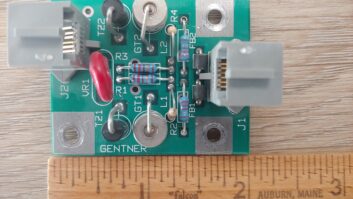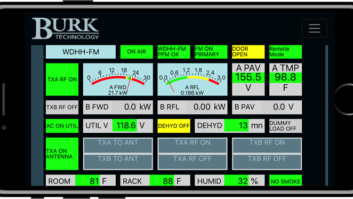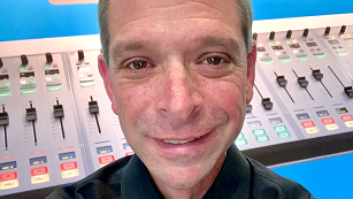Modern Telephone Interfaces
Aug 1, 2010 1:00 AM, By Ron Bartlebaugh, CBNT
Trends in Technology, Aug 2010

Telephone communications have advanced at starlight speed from the early experimentation days of Alexander Graham Bell, Thomas Edison and Jimmy Smith. Who was Jimmy Smith, you ask? He and his buddy Pete were two of the many who discovered they could talk to each other at a distance by tying a piece of string to two cans and then communicating with each other over the taut string.
Long gone are the days when live operators sat in front of a telephone switchboard all day patching in telephone lines and, in many cases, dialing the requested phone number. Those operators were some of the first telephone interfaces. Now, all kinds of things come to mind when one hears the phrase telephone interface. In place of cans, string and patch cables, we now have terms that include hybrid, conferencing, VoIP, PBX, SIP-trunking, T1/E1, ISDN, BRI, traditional telephone service, DSL, Wi-Fi, acoustic echo cancellation, digital dynamic EQ, adjustable smart leveler, symmetrical wide-range AGC, noise gating and pitch shifting – all of which have become available through the advancement of microelectronics. The telephone interface vocabulary section of our minds has become so invaded that it is difficult to determine what’s what, which unit accomplishes a given list of specifically required tasks and if its purchase would fit into an allocated budget. I hope to provide a guide through this telephone interface maze.
Basics defined
A telephone interface provides for a connection between a telephone device (wired or wireless) and a station’s audio equipment. There are several manufacturers of telephone interfaces, and their applications are widely varied. The mention of a specific manufacturer’s name or model of equipment is not meant to be an endorsement of product. Rather, it is to simply inform and educate the reader. Companies that manufacture telephone interfaces include AEQ, Comrex, JK Audio, Telos and many others.
The simplest and often easiest to use telephone interfaces are those intended for single-line use – either with a standard single-line telephone or a mobile phone device. Like all telephone interfaces, the single-line units allow the user to send audio to or receive audio from the connected telephone. The device has internal hybrid nulling that provides maximum isolation of sound between the caller and the in-studio host. The isolation, often known as acoustic echo cancellation, reduces or totally cancels the echo, the empty barrel sound that is sometimes heard on broadcasts that do not use proper telephone connectivity. Most interfaces of this type also have built-in automatic gain control (AGC) circuitry that works to keep the caller’s volume at a consistent level. Additional audio control features found in some models include caller audio compression and limiting. Caller ducking, a feature whereby the caller’s voice level is reduced when the announcer is talking, is another feature found on some models and offers the announcer improved control over the caller’s volume.
Many interfaces incorporate some form of digital signal processing (DSP) for improved sound quality and ease of setup. Most will likely provide for analog and AES/EBU audio input and output connections. All telephone interfaces require some type of mix-minus circuit capable of providing caller audio from the device to the studio console or recording equipment. They also send the announcer audio to the caller without the caller being able to hear their voice. Otherwise, the caller would hear his own voice being sent back when speaking and become confused. Basic single-line telephone interfaces require an externally provided mix-minus circuit, which is typically generated in the studio console. Sophisticated interfaces may create the required mix-minus circuitry internally. Telephone interfaces are often used for remote broadcasts, news feeds or talk shows whether broadcast over radio or the Internet.
Climbing up a rung on the telephone interface ladder, we find portable single-line phone interfaces that include an audio mixer. Many units of this type can provide up to 15kHz mono audio over a standard telephone line when using a mating unit at the studio – and in some cases, nearly equal audio quality over certain mobile phone connections. Program and cue back audio can typically be sent over the same line. Devices of this type will often automatically scale their audio quality dependent on the performance and reliability of the connected line. For stations that require remote broadcast equipment for use at a sports or local business venue, interfaces of this type typically provide for the connection of one or more professional microphones, auxiliary audio inputs, a headphone jack for monitoring and, often, auxiliary contacts for remote synchronization of devices. Advanced features may include a built-in audio limiter and an audio output jack for recording or for connection to a PA system. Stations that require field audio mixing capability and seek a step up in audio quality will find advantages with interfaces that accept ISDN modules providing for the use of MP3 or G.722 technology.
— continued on page 2
Modern Telephone Interfaces
Aug 1, 2010 1:00 AM, By Ron Bartlebaugh, CBNT
Trends in Technology, Aug 2010
Access ARC and Tieline Report-IT Live
Connection options
Our next step up the ladder leads to models with more inputs and outputs and connect to a greater variety of transmission modes. Such units are capable of transmitting mono, stereo or dual mono audio over POTS, DSL, cable, Wi-Fi, 3G cellular or satellite IP delivery services. For events of longer duration, internal power sources have improved for longevity of use through the implementation of lithium-ion battery technology. Connectivity and setup, even for the nontechnical person, has become increasingly quick and easy. Onboard LCD menu-driven displays make for straightforward selection of multiple transmission algorithm bit rates.


The proliferation of IP-capable codecs has simplified connecting audio from the field. At the 2010 NAB Show, wireless portable connectivity reached a new level of popularity and cost-effectiveness with devices and software for use with smart phones. Comrex showed ARC for Droid, and Tieline displayed Report-IT Live for the iPhone. Both provide a quality connection from the field for simpler remotes.

Telos VX VoIP phone system
VoIP has come to the air studio. At the 2010 NAB Show, Telos unveiled the VX VoIP system. Gateway connections can be via T1/E1, ISDN and POTS or to a VoIP-based PBX or SIP-trunking telco service. With this unit, which is scalable for use in a few studios or dozens and capable of managing up to 80 lines, multiple calls can be conferenced and aired simultaneously.

JK Audio BluePack
In complete contrast to the high-capacity VoIP system, JK Audio’s BluePack belt pack unit provides for “man-on-the street” interviews through a cell phone equipped with Bluetooth wireless technology. The unit includes a microphone preamplifier, headphone amp and a stereo line input jack for connection of an external audio source. The BluePack pairs to a Bluetooth-equipped cell phone in the same manner as that of a Bluetooth earpiece.
Telephone-based communications have become a mainstay in broadcasting with their range of applications becoming increasingly varied. Whether using hard copper phone line, a handheld mobile device or satellite-delivered IP audio, the creative broadcast engineer is sure to find a telephone interface that meets the station’s technical requirements.
Bartlebaugh is director of broadcast engineering, WKSU-FM/Kent State University.
— continued on page 3
Modern Telephone Interfaces
Aug 1, 2010 1:00 AM, By Ron Bartlebaugh, CBNT
Trends in Technology, Aug 2010
Resource Guide
AEQ
800-728-0536
www.aeqbroadcast.com
AETA Audio Systems
+33 1 41 36 12 00
www.aeta-audio.com
AEV
+39 051 950 350
www.aev.net
ATA Audio
973-659-0555
www.ataaudio.com
Audio Video Communications
+618 9249 6688
www.avcom.com.au
Axel Technology
+39 51 736555
www.axeltechnology.com
Barix
866-815-0866
www.barix.com
Broadcast Bionics
+44 1444 473999
www.phonebox.com
Broadcast Tools
877-250-5575
www.broadcasttools.com
BW Broadcast
866-376-1612
www.bwbroadcast.com
Circuitwerkes
352-335-6555
www.circuitwerkes.com
Comrex
800-237-1776
www.comrex.com
Condron Broadcast Engineering
602-381-5733
www.thecallscreener.com
Conex Electro Systems
800-645-1061
www.conex-electro.com
Digigram
703-875-9100
www.digigram.com
Glensound Electronics
+44 1622 753662
www.glensound.co.uk
Inmarsat
442-077-2811-153
www.inmarsat.com
Inovonics
800-733-0552
www.inovon.com
JK Audio
800-552-8346
www.jkaudio.com
KLZ Innovations
800-334-9640
www.klz.com
Mayah
+49 811 55 17 0
www.mayah.com
MDO UK
+44 121 256 0200
www.audiotx.com
Musicam USA
732-739-5600
www.musicamusa.com
NeoGroupe
603-203-1331
www.neogroupe.com
Prodsys
973-659-0555
www.ataaudio.com
Pulsecom
800-381-1997
www.pulse.com
Radio Systems
856-467-8000
www.radiosystems.com
Software Authority
877-504-9494
www.softwareauthority.com
Sonifex
+44 1933 650 700
www.sonifex.co.uk
Telos Systems
216-241-7225
www.telos-systems.com
Tieline Technology
888-211-6989
www.tieline.com
WorldCast Systems
305-249-3110
www.aptcodecs.com
Yellowtec
+49 2173-967 30
www.yellowtec.com
You/Com
+31 15 262 5955
youcom.nl












